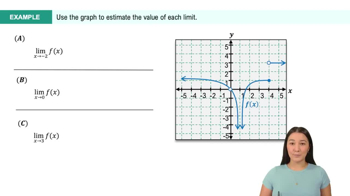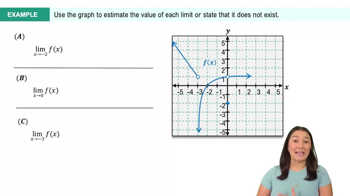Table of contents
- 0. Functions7h 52m
- Introduction to Functions16m
- Piecewise Functions10m
- Properties of Functions9m
- Common Functions1h 8m
- Transformations5m
- Combining Functions27m
- Exponent rules32m
- Exponential Functions28m
- Logarithmic Functions24m
- Properties of Logarithms34m
- Exponential & Logarithmic Equations35m
- Introduction to Trigonometric Functions38m
- Graphs of Trigonometric Functions44m
- Trigonometric Identities47m
- Inverse Trigonometric Functions48m
- 1. Limits and Continuity2h 2m
- 2. Intro to Derivatives1h 33m
- 3. Techniques of Differentiation3h 18m
- 4. Applications of Derivatives2h 38m
- 5. Graphical Applications of Derivatives6h 2m
- 6. Derivatives of Inverse, Exponential, & Logarithmic Functions2h 37m
- 7. Antiderivatives & Indefinite Integrals1h 26m
1. Limits and Continuity
Introduction to Limits
Problem 2.2.49
Textbook Question
Sketch the graph of a function with the given properties. You do not need to find a formula for the function.
p(0) = 2,lim x→0 p(x) = 0,lim x→2 p(x) does not exist, p(2)=lim x→2^+ p(x)=1
 Verified step by step guidance
Verified step by step guidance1
Step 1: Start by plotting the point (0, 2) on the graph, as given by p(0) = 2. This indicates that the function passes through this point.
Step 2: Consider the limit as x approaches 0. The limit \( \lim_{x \to 0} p(x) = 0 \) suggests that as x gets very close to 0 from either side, the function value approaches 0. This implies a discontinuity at x = 0 since p(0) = 2.
Step 3: Analyze the behavior around x = 2. The limit \( \lim_{x \to 2} p(x) \) does not exist, indicating a discontinuity at x = 2. However, \( \lim_{x \to 2^+} p(x) = 1 \) tells us that as x approaches 2 from the right, the function value approaches 1.
Step 4: Plot the point (2, 1) on the graph to represent the right-hand limit at x = 2. Since the limit from the left does not exist, the function may have a jump or an asymptote at x = 2.
Step 5: Sketch the graph by connecting the points and considering the limits. The graph should approach 0 as x approaches 0 from either side, jump to 2 at x = 0, and then approach 1 from the right as x approaches 2.
Recommended similar problem, with video answer:
 Verified Solution
Verified SolutionThis video solution was recommended by our tutors as helpful for the problem above
Video duration:
5mPlay a video:
Was this helpful?

 6:47m
6:47mWatch next
Master Finding Limits Numerically and Graphically with a bite sized video explanation from Callie
Start learning





